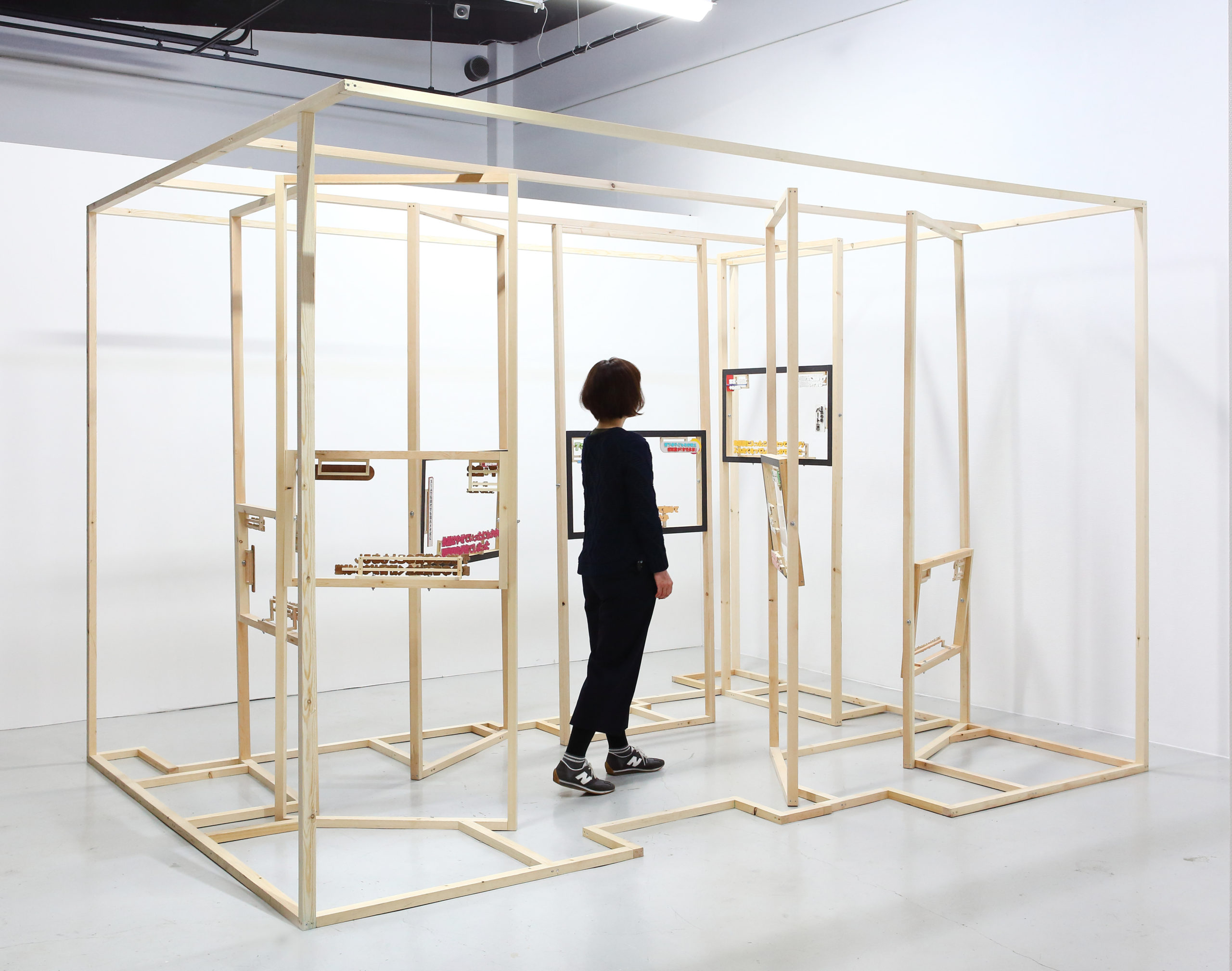タイトル:ゆるんだ遠近法
時期:2017年1月14日〜2月5日
場所:gallery COEXIST – TOKYO
アーティスト:上竹真奈美 / 佐々木かなえ / 鈴木貴徳 / 根本祐杜 / 原田賢幸 / 渡邊拓也
主催:文化庁、NPO法人アーツイニシテアティヴトウキョウ[AIT/エイト]
Fragile Perspectives
January 14 – February 5, 2017
Venue : gallery COEXIST – TOKYO
Artists : Manami Uetake / Kanae Sasaki / Takanori Suzuki / Yuto Nemoto / Masayuki Harada / Takuya Watanabe
Organized by : Agency for Cultural Affairs, Government of Japan, Arts Initiative Tokyo [AIT]
ゆるんだ遠近法
人と人のつながりの定まらなさとは何に因るのだろうか。兄弟姉妹、家族、友だち、同僚、恋人。仲たがいをしたり疎遠になったりしては元にもどる繰り返しは、人の間に目に見えないゴムのようなものがあって、伸びたり縮んだりしているようだ。「ゆるんだ遠近法」と名づけられた展覧会は、これからの時代を担う芸術家が、そうした人と人の間の距離感について思いを巡らせて制作した作品で構成されている。
なぜ、人と人の関係は定まらないのか。それは、谷崎潤一郎の「友田と松永の話」を持ち出すまでもなく、「私」というものがそもそも定まらないからではないだろうか。同一人物でありながら、時々で変わる信じる対象によって人格や体つき、生活様式、名前までも変わってしまうその登場人物のように、人というのは、その人自身というよりも、「周り」によって決められてしまう部分が大きいのかもしれない。つまり、「周り」によっては、「私」は、「私」でさえ思いもよらない人になってしまうということだ。
「周り」との関係において、人は、絶えず揺れている。ということは、人と人の関係もきっとそうなのであろう。時にはそれが増幅することもあるだろうし、互いに吸収しあって安定しているように見えることもある。谷崎の小説では、主人公は明治の開国時に流入したヨーロッパの価値観あるいは生活様式と日本の地に根づいていたそれらの狭間で揺れ動いていたが、今では世界中に手足を伸ばして広がった資本主義によって情報やモノがこの惑星のあらゆるところからやってくる。それがまた、いまどきの「人」を揺らしながら形づくっている。こうした時代にあって、人と人の関係は、マスメディアに取り上げられると画一的なものとして表される一方で、実生活においては複雑なものとして経験されるのかもしれない。情報やモノ、さらに生きられた経験の間で、人は、その人らしさを求めてたえず揺れ、さらにそれらの関係も定まらぬものとなっているのだろう。
佐々木かなえは、メディアが取り上げる彼女と同世代の女性に関する社会的問題に目を向け、彼女自身の部屋でそうした人々を演じることによって、モニターの向こうとこちらで生きる同世代の関係を図っているようだ。根本祐杜は、惑星規模のスペクタクルになっているオリンピックやそこで活躍するアスリートと彼自身の頼りない体の間を扱う。上竹真菜美は、この数年で再びよく話をするようになった父親との親密な会話をとおして、全国各地の建設現場を渡り歩いてきた彼の人生に目を向ける。そして渡邊拓也は、タイル工場の熟練工員の労働についての言葉を繰り返しながら彼が歩んできた人生を全身で引き受けようとする。鈴木貴徳は、偶然たどり着いた田舎の引っ越し先の家に住んでいた今は亡き木こりに想いを寄せ弔う。原田賢幸は、伸びきったゴムのように遠のいてしまった両親の間を取り持つ装置を作り、それがどのように機能するのかを科学的な手法を使って試している。いずれの作品も、芸術家自らの思い以上に、向き合う対象によって伸び縮みする距離感を、作品を成り立たせるための重要な要素にしているようだ。
ここで、もう一つ、作品の展示作業を巡り、若き芸術家たちの間でそうした距離感の伸縮があったことを書き留めておきたい。本展は、6人の芸術家の展覧会としては比較的限られた空間で行われたため、作品の配置に気を配る必要があった。それは、とりも直さず芸術家どうしが対話と思考と実験と納得を重ねることによって、作品の位置や見え方、鑑賞者の動線を見極めてゆくことに他ならなかった。そして、その作業は展覧会が開いてもなお重ねられ、あり得たかもしれない最適な展示方法を巡り、作品の位置の入れ替えあるいは照明や台座の変更などの作業が繰り返された。芸術家たちは揺れ、その集合であるこの展覧会もまるで生き物であるかのごとく姿を変えていった。
この入れ子のようになった人と人の結びつきを探る試みは、何を意味するのだろうか。「ゆるんだ遠近法」の「ゆるむ」というのは、「寒さがゆるんで春になる」ときのように、変わることの謂いを含んでいる。それは、他人に向き合って己を絶えず変えてゆく可能性に開いているということだ。迷い、焦り、怒り、労わり、慈しみ、悩みながら、あきらめずに他人との回路を開いて関係をとりつづける。それは、やがて見知らぬものに出会ったときに臆せずそれらに向き合うことのできるしなやかな考えや態度、行為となって表れることだろう。そして、それがまた、彼ら彼女たちの芸術の豊かさへと結ばれてゆくことは想像に難くない。
小澤慶介(キュレーター)
Fragile Perspectives
What is it about the uncertainty of human relations that troubles us? From siblings and family relatives to friends, colleagues, and lovers, the cycle of breaking up, estrangement and making up would seem to be somewhat like invisible rubber material that exists between us, always stretching and contracting. This exhibition, “Fragile Perspectives,” features the work of up-and-coming artists exploring ideas about this sense of distance between people.
Why are human relations uncertain? We don’t have to rely on Jun’ ichiro Tanizaki’s The Strange Case of Tomoda and Matsunaga to suggest that it is in fact because “I,” the self, is uncertain. In Tanizaki novella, the two characters are the same man, yet he changes his personality, build, lifestyle and even name according to whatever his inclination is at a certain time. As such, who a person is, is decided less by him or herself than by what is around them. That is, depending on what is around me, “I” may be a person who is inconceivable even to myself.
People are constantly unsettled in their relationships with what is around them. That is to say, this is also surely so for relationships between people. At times, this may be amplified, though it may also seem to be stabilizing us. In the Tanizaki novella, the main character is attracted to the new European values and lifestyle imported into Japan after the country opened up to the outside world during the Meiji period (1868-1912). Today, information and things is everywhere thanks to the advance of capitalism, which has spread its tentacles all over the world. This situation sways yet also shapes the “person” of today. In an age like today, the relationships between people are represented, on the one hand, in ways that are uniform according to the mass media, yet are perhaps experienced as more complex in actual life. In between information, things and the lifestyles we lead, people demand this humanity and thus are forever in flux; moreover, their relationships are also in a state of uncertainty.
Kanae Sasaki focuses on her generation of women’s social problems that are discussed in the media. Performing these people in her own room, she seems to attempt a relationship between the world on the other side of the TV screen and her generation living on this side. Yuto Nemoto deals with the gap separating the global spectacle that is the Olympics, the athletes who compete, and his own weak body. Through an intimate conversation with her father, with whom she has only started to talk properly again these past few years, Manami Uetake examines the life he led migrating between various construction sites around Japan. Takuya Watanabe, meanwhile, repeats phrases about a veteran worker at a tile factory as he seemingly tries to take on the life of the worker with his entire body. Takanori Suzuki mourns the late lumberjack who used to live at the house he has coincidentally moved to in the countryside. Masayuki Harada built a device that mediates the gulf that now exists between his parents, like rubber that has been stretched, and uses scientific means to test how it could function. More than the personal ideas of the artists, all of these artworks seem to treat a sense of distance that expands and contracts according to the subject matter as important elements for making up the work.
Here I would like to note something further: how this sense of distance between the young artists actually expanded and contracted during the process of organizing how to exhibit these artworks. For an exhibition of the work of six artists, the exhibition took place in a comparatively small space, which necessitated care in the arrangement of the exhibits. That is to say, the only way to determine the position of the artworks, how they would be seen in the space, and the flow of visitors was through a process of dialogue, brainstorming, experimentation, and understanding between the artists. This task continued even after the exhibition opened in the form of changes to the arrangement of the artworks or changes to lighting or plinths, exploring other optimal ways to exhibit the works. The artists and the group exhibition itself transformed into something almost like a single living creature.
What is the meaning of this attempt to search for the binds between people? The “fragile” of “Fragile Perspectives” conveys the nuance of how things are always tenuous and shifting, in the same way as the cold weather gradually yet inevitably unwinds into spring. That is, it is open to the possibility that the self is constantly changing when facing others. Bewildered, impatient, angered, sympathetic, loving, troubled never giving up, we continue to open up paths with others and hold relationships. This manifests as the supple ideas, attitude and actions whereby we can fearlessly confront the unknown whenever we encounter it. And it is not difficult to imagine how this links up with the richness in the work of these artists.
Keisuke Ozawa (Curator)

